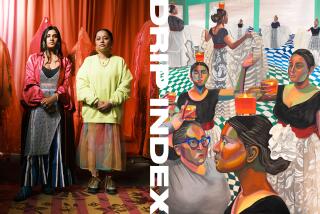Photography: Home-grown angle to three fall shows
What do the three most notable photography shows of the fall have in common? All of them look to L.A. for their source material. Two focus on photographers whose long careers are based here, and one honors the vision of a pair of local collectors.
When curators turn locavore, audiences follow. In wake of “Pacific Standard Time,” the 2011-12 Getty initiative to mine the history of postwar art in L.A, receptivity to the home-grown has never been higher. Nor has awareness of L.A.’s role on the national and global artmaking and exhibition circuit been greater.
Another interesting question to ask of the coming season, speaking of interconnected histories, reciprocal influence and overdue attention: What does it suggest that so many of the fall’s most significant shows overall center on photography? Something to ponder in the coming months, while roaming the print-packed museums.
CHEAT SHEET: Fall arts preview
“John Divola: As Far As I Could Get” is a geographically ambitious collaboration led by the Santa Barbara Museum of Art, working with the Los Angeles County Museum of Art and the Pomona College Art Museum. The show takes its title from a series of photographs (1996-2010) that Divola made of himself sprinting down alleys and desert roads, through desolate fields and city streets, away from his tripod-mounted camera set on a 10-second timer.
What the lens captures and what escapes it have intrigued Divola, who teaches at UC Riverside, throughout his 40-year career. The L.A. native, 62, earned his master’s in fine arts at UCLA under Robert Heinecken, adopting early on an elastic approach to the medium of photography, playing off its dual status as object and window, and making painting and performance integral aspects of his work.
He first came to broad critical attention in the late ‘70s for pictures he made in an abandoned house on Malibu’s Zuma Beach. Divola used the walls of the decaying structure as a painting surface (peppering them with patterns of dots and dashes) and also a framing device, shooting out the window at the union of sea and sky during the luminous hours of dawn and dusk.
The three-part exhibition, which Divola characterizes as a “retrospective-ish thing,” has staggered opening dates in September and October and a nonchronological format. It surveys the artist’s push-pull investigation into photography’s nature as both a tool for literal description and instrument of conceptual abstraction, but it draws no definitive conclusions, which suits him perfectly.
PHOTOS: Arts and culture in pictures by The Times
“Photography is an index of a lived life,” he says. “There’s a lot of continuity and discontinuity. There are lots of threads, but I’m skeptical of a universal summation.”
“James Welling: Monograph,” at the Hammer Museum (opening Sept. 29), is a comprehensive take on a long, diverse career probing photography’s multiple personalities. Welling, born in 1951, studied under John Baldessari at the California Institute of the Arts in the early ‘70s, engaging from the start with both the meaning and materiality of photographs.
In his early images of Los Angeles architecture, Welling spun off the muted aesthetic of New Topographics with his own style of subjective inventory. He went on to produce a series of small (4- by 5-inch) images of crinkled aluminum foil that read as abstract textural fields — light on water, faces of chiseled stone, moonscapes. Welling’s work is not just ambiguous but also pointedly about ambiguity. It might stir the emotions, but with one eye coolly trained on how that emotionality is generated.
A longtime professor at UCLA, Welling has referred to himself as a ventriloquist, throwing his voice into different sorts of pictures. Echoes of Walker Evans’ documentary style resound in one body of work, and László Moholy-Nagy’s abstract photograms in another. Over nearly four decades, he has navigated an idiosyncratic path through the influences of European and American modernist photography, post-Minimalist sculpture and Conceptualism, assimilating and critiquing along the way.
The exhibition, which originated at the Cincinnati Art Museum, spans the Welling spectrum, through 200 photographs from two dozen discrete series.
In 2008, LACMA acquired the 3,600-piece photography collection of Angelenos Leonard and Marjorie Vernon. A small show was staged that year, accompanied by a slim catalog. On Oct. 27, the museum opens “See the Light — Photography, Perception, Cognition: The Marjorie and Leonard Vernon Collection.”
Built over the course of three decades, the collection spans photography’s entire history. The largest single acquisition of photographs made by the museum, it “changed the entire scope of our collection,” and gives rise to infinite interpretations, says curator Britt Salvesen.
The upcoming show of some 220 images is based “on the collection’s strengths and the Vernons’ instincts for what we would call ‘camera vision.’” Salvesen opted for “a cross-disciplinary, art-science approach” that will be further explored in a catalog with commentaries by researchers in a variety of fields.
If, after all of this attention to photographs generated and gathered close to home, you feel the need to turn your gaze farther afield, several other shows opening this fall provide perfect counterpoint. The Getty Museum offers “At the Window: A Photographer’s View” (opening Oct. 1), a historical overview of the window as compositional and conceptual framing device.
And finally, in tribute to one of the best vehicles for armchair exploration, the Annenberg Space for Photography presents (opening Oct. 26) “The Power of Photography: National Geographic 125 Years,” with more than 400 pictures displayed mosaic-style on the walls, and an additional 500 in a digital installation.
MORE
PHOTOS: Hollywood stars on stage
CHEAT SHEET: Fall Arts Preview
PHOTOS: Arts and culture in pictures
More to Read
The biggest entertainment stories
Get our big stories about Hollywood, film, television, music, arts, culture and more right in your inbox as soon as they publish.
You may occasionally receive promotional content from the Los Angeles Times.










